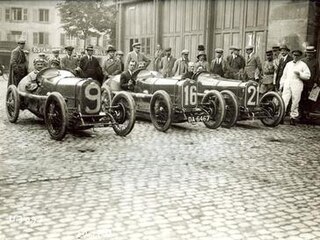
Automobiles Ettore Bugatti was a German then French manufacturer of high-performance automobiles. The company was founded in 1909 in the then-German city of Molsheim, Alsace, by the Italian-born industrial designer Ettore Bugatti. The cars were known for their design beauty and numerous race victories. Famous Bugatti automobiles include the Type 35 Grand Prix cars, the Type 41 "Royale", the Type 57 "Atlantic" and the Type 55 sports car.

Eugène Adrien Roland Georges Garros was a French aviation pioneer and fighter pilot. Garros began a career in aviation in 1909 and performed many early feats such as the first-ever airplane crossing of the Mediterranean Sea in 1913. He joined the French army and became one of the earliest fighter pilots during World War I. Garros was shot down and died on 5 October 1918. In 1928, the Roland Garros tennis stadium was named in his memory; the French Open tennis tournament officially takes the name of Roland Garros, which is held in this stadium.

The Bugatti Veyron EB 16.4 is a mid-engine sports car, designed and developed in Germany by the Volkswagen Group and Bugatti and manufactured in Molsheim, France, by French automobile manufacturer Bugatti. It was named after the racing driver Pierre Veyron.

The Bugatti Type 57 and later variants was a grand tourer built from 1934 through 1940. It was an entirely new design created by Jean Bugatti, son of founder Ettore. A total of 710 Type 57s were produced.

The Bugatti Type 13 was the first true Bugatti car. Production of the Type 13, and later Types 15, 17, 22, and 23, began with the company's founding in 1910 and lasted through 1920, with 435 examples produced. Most road cars used an eight-valve engine, though five Type 13 racers had 16-valve heads, some of the first ever produced. The road cars became known as pur-sang ("thoroughbred") in keeping with Ettore Bugatti's feelings for his designs.

The Bugatti Type 35 is an iconic race car design produced by Bugatti at their Molsheim premises between 1924 and 1930. It was extremely successful when raced by the factory works team. It was also bought by a diverse roster of privateer clientele from around the world. It pioneered the concept of a holistically conceived, race-ready car available for purchase.

The Bugatti Type 51 series succeeded the famous Type 35 as Bugatti's premier racing car for the 1930s. The main distinction is that it uses a twin cam engine. Unlike the dominant Type 35s of the prior decade, the Type 51 were unable to compete with the government-supported German and Italian offerings.

The Bugatti Type 41, better known as the Royale, is a large luxury car built by Bugatti from 1927 to 1933, With a 4.3 m (169.3 in) wheelbase and 6.4 m (21 ft) overall length, it weighs approximately 3,175 kg (7,000 lb) and uses a 12.763 litre (778 cu in) straight-eight engine. For comparison, against the Rolls-Royce Phantom VII, the Royale is about 20% longer, and more than 25% heavier. This makes the Royale one of the largest cars in the world. Furthermore, with the limited production run and the premium nature of the vehicle, it is also both one of the rarest and most expensive.

The Bugatti Type 32, commonly called the Tank de Tours, was a streamlined racing car built in 1923. It was built to compete in the French Grand Prix, which was held on July 2 in Tours on the same year.

The Vauxhall Prince Henry was a car manufactured by Vauxhall from 1911 to 1914. It had a length of around 4.05 metres (159.4 in) and a weight of 1,250 kg (2,756 lb) depending on the model and the coachwork fitted.

The Bentley 3 Litre was a car chassis manufactured by Bentley. The company's first, it was developed from 1919 and made available to customers' coachbuilders from 1921 to 1929. The Bentley was very much larger than the 1368 cc Bugattis that dominated racing at the time, but double the size of engine and strength compensated for the extra weight. The 4000 lb (1800 kg) car won the 24 Hours of Le Mans in 1924, with drivers John Duff and Frank Clement, and again in 1927, this time in Super Sports form, with drivers S. C. H. "Sammy" Davis and Dudley Benjafield. Its weight, size, and speed prompted Ettore Bugatti to call it "the fastest lorry in the world", which was regarded as a compliment. Built in 3 main variants, Blue label, Red Label Speed models all carrying a 5-year warranty, and the coveted and rare Green Label 100 mph cars, which only carried a 12-month warranty reflecting the high state of tune.

The Halford Special was a Grand Prix racing car of the 1920s built by engine designer Major Frank Halford on the chassis of an early Side Valve Aston Martin tourer. It was one of the most advanced British-built racing cars of the mid-1920s and had many racing successes. Halford himself was a freelance engine designer who did work for both the de Havilland Aircraft Company and Napier & Son.

The Peugeot Bébé or Baby was a small car nameplate from Peugeot made from 1905 to 1916. Vehicles under this name were known technically within Peugeot as the Type 69 and the Type BP1.

The Bugatti Type 57S Atalante number 57502, built in 1937 by Automobiles Ettore Bugatti, is one of 43 Bugatti Type 57S made and one of only 17 Type 57S produced with the in-house Atalante coupé coachwork. The car hit the headlines in 2009 when auctioned by Bonhams, after having been rediscovered in 2008, following 48 years of storage in a private owner's garage in Gosforth, England, with few people aware of its location.

The Louwman Museum is a museum for historic cars, coaches, and motorcycles in The Hague, Netherlands. It has been situated on the Leidsestraatweg near the A44 motorway since 2010. The museum's former names are "Nationaal Automobiel Museum" and "Louwman Collection".

Bentley Blower No.1 is a racing car developed from the Bentley 4½ Litre by Sir Henry "Tim" Birkin to win the Le Mans twenty-four-hour race. The car was developed into its current form for racing at Brooklands.

Clément-Talbot Limited was a British motor vehicle manufacturer with its works in Ladbroke Grove, North Kensington, London, founded in 1903. The new business's capital was arranged by Charles Chetwynd-Talbot, shareholders included automobile manufacturer, Adolphe Clément, along with Baron Auguste Lucas and Emile Lamberjack, all of France.

Sunbeam Works Racing cars participated in the 1922 XVI Grand Prix de l'A.C.F. in Strasbourg. The race took place on 15 July 1922 and was run to a formula stipulating that maximum engine capacity should not exceed 2 litres and that the cars should be two-seaters weighing not less than 650 kg. The formula was to remain in force for four years producing "fields of brilliance to be unequalled for many years" it was the first rolling massed start in the history of Grand Prix motor-racing.

Ivy Cummings (1901–1971) was an early racing car driver, reputedly the youngest person ever to lap Brooklands. In 2009 her Bugatti car sold for over £2m.























